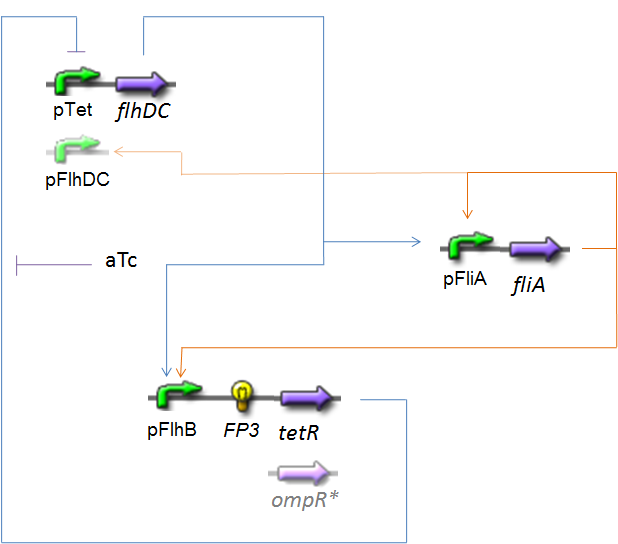Team:Paris/Modeling/Oscillations
From 2008.igem.org
(→Resulting Equations) |
(→Resulting Equations) |
||
| Line 30: | Line 30: | ||
First, we introduce here what we assume to be in our model '''the involved chemical reactions'''. They are written in '''black''', regards to the equations that concerns both of the [[Team:Paris/Modeling/Oscillations#The_Circuit|alternatives]]. | First, we introduce here what we assume to be in our model '''the involved chemical reactions'''. They are written in '''black''', regards to the equations that concerns both of the [[Team:Paris/Modeling/Oscillations#The_Circuit|alternatives]]. | ||
| - | Then, the | + | Then, the red and green equations are those implemented in our [[Team:Paris/Modeling/Programs|simulation programs]]. |
| - | The '''blue''' ones correspond to the reactions of '''complexation''', and the '''red''' ones just below are the | + | The '''blue''' ones correspond to the reactions of '''complexation''', and the '''red''' ones just below are the complexations functions that are their consequences if their stady-state are immediatly reached (see [[Team:Paris/Modeling/Oscillations#Biochemical_Assumptions|Biochemical Assumptions]]). |
The '''green''' ones correspond to the reaction of '''production''' of proteins. | The '''green''' ones correspond to the reaction of '''production''' of proteins. | ||
Revision as of 17:12, 15 September 2008
OscillationsThe CircuitWe just keep here the following circuit, constituing the Oscillations. The gene FP3 codes for the third reporter protein we will use in our final system. We have two alternatives for the promoter before flhDC : pTet or pFlhDC. These two alternatives are both studied in what follows.
Biochemical AssumptionsWe do not take into acount the phenomenon of translation : we consider the transduction as leading directly to the production of the protein (see however considerations on RBS). We assume that the expression rate of an inducible promoter is proportionnal to the number of created complexes promoter-inducer. In the same way, a repressible promoter has got a basal expression, and its expression is proportionnal to the number of free promoters. Moreover, we consider that in a cell, the amount of a transcription factor is far more important than the amount of the corresponding promoter, such that the total concentration of the transcription factor is equal to the concentration of the free transcription factor (not bound to the promoter). In this way, we can assume that for all the complexation reaction, the only variable to consider is the total concentration of the transcription factor, without taking into acount a possible kinetically predominant reaction. Then, in order to consider these complexes and free promoters, we just consider the complexation reaction between the transcription factor and the promoter. If we consider that the steady-states of these equations are reached much quickly than the proteins are produced, that leads to promoter's expressions well described by Hill function. We use that property to get different constants involved in the equations below, but we will probably simulate the complexation reactions in our implementation, by giving an arbitrary value for all the complexation rate (k+), each the same for all complexation reactions, and by deducing the dissociation rate (k-) thanks to the dissociation constant (K) we found (see estimation of parameters). Endly, we suppose that the contribution of the two inducers FliA and FlhDC on PflhB are synthetised by a SUM logical gate. Resulting EquationsFirst, we introduce here what we assume to be in our model the involved chemical reactions. They are written in black, regards to the equations that concerns both of the alternatives. Then, the red and green equations are those implemented in our simulation programs. The blue ones correspond to the reactions of complexation, and the red ones just below are the complexations functions that are their consequences if their stady-state are immediatly reached (see Biochemical Assumptions). The green ones correspond to the reaction of production of proteins.
|
 "
"

